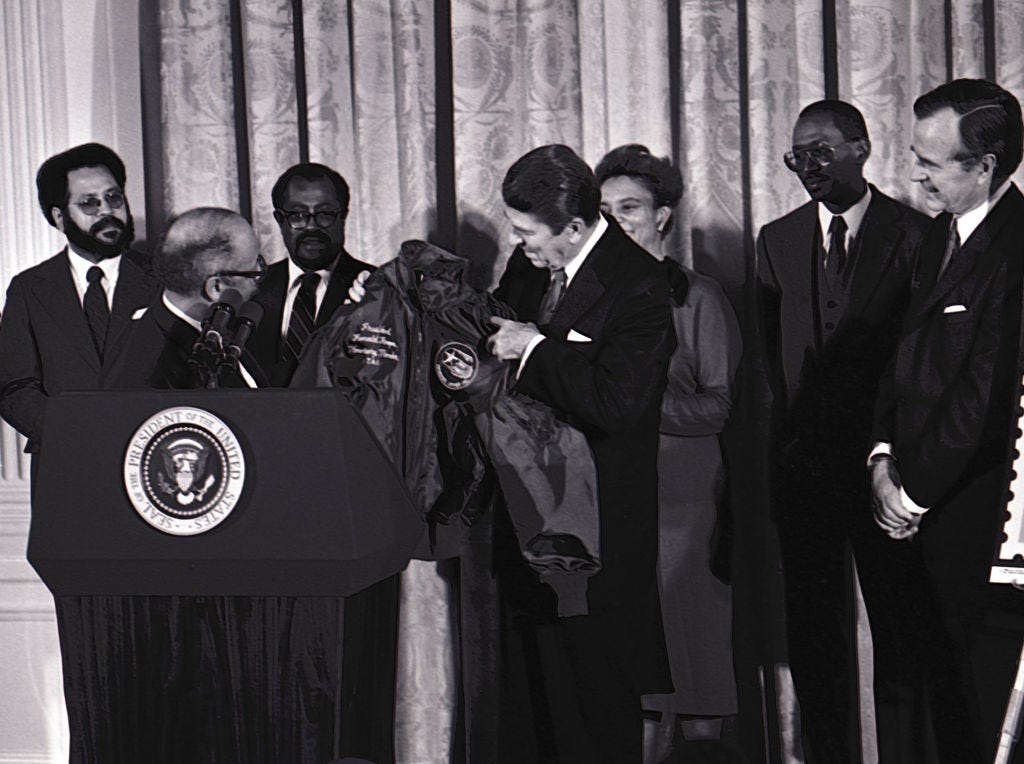Where Do We Stand: A ‘Correlation of Forces’ Assessment.
What might actually stop Trump? Let's go through some possibilities—which finally come down to each of us.
Newly commissioned pilots from the Tuskegee Airmen, studying maps before a mission in 1942. The military heritage of the Tuskegee Airmen was downplayed during the initial “anti-DEI” effort of the Trump/Hegseth Pentagon—as was the bravery of the Navajo Code Talkers, the Japanese-American infantrymen of the Army’s 442nd combat regiment, and the countless other women and non-white men who served and sacrificed in the name of American values.
These Airmen, like all combatants, needed to know the enemy’s strongest and weakest points to be effective in attack. What do we know about the strongest and weakest points of the movement now attacking the foundations of American democracy? Some guidelines below. (Photo by Afro American Newspapers/Gado/Getty Images.)
This post is about “correlation of forces,” as it applies to the current emergency struggle between Donald Trump plus his enablers and supporters, versus the Constitutional heritage of the United States.
During the Cold War era, “correlation of forces” was a Soviet term to assess the overall strategic balance between their bloc and the Western bloc led by the United States. For instance, in 1975, around the time of the fall of Saigon and Richard Nixon’s resignation, a Soviet general wrote that “the correlation of world forces has changed fundamentally in favor of socialism and to the detriment of capitalism.”
He turned out to be wrong, but that’s for another time.1 My point now is the timeless importance, in any struggle, of clearly perceiving an adversary’s strengths and vulnerabilities, and assessing how much is at stake in the outcome. And being at least as clear-eyed about one’s own strong and weak points.
I’m thinking about this because of Chuck Schumer’s marathon appearance on Chris Hayes’s MSNBC show last night. Schumer spent a minute or two promoting his latest book, but mainly he was there to rebut criticism of his decision not to filibuster the Trump-Musk-Doge “continuing resolution” last week.
Without using the term, Schumer’s defense of his choice was essentially “correlation of forces.” That is: The Republicans had the votes, the Democrats didn’t, and thus the Democrats’ options boiled down to bad, versus worse.
Bad was dropping the filibuster (as Schumer recommended, and they did) and letting the Republicans’ “Blank check for Musk” resolution go through. Worse—in Schumer’s view—would have been mounting a filibuster, which in turn might have forced a government shutdown, which in turn might have given Musk and Trump even broader control over the government and exposed Dems to possible “mess in Washington” blame.
I argued last week why I thought the Dems should have fought it out. And yesterday David Lurie had an eloquent and detailed argument that if the Dems ended up having to choose between bad, and worse, that was largely because of their—and Schumer’s—fecklessness in the preceding months.
But that’s past. The emerging “correlation of forces” point involves what Schumer said would come next.
-Chris Hayes asked him if the US was already in a Constitutional emergency. Schumer said Not yet. Why? Because, according to Schumer, up to now Trump had not flat-out defied orders from the Supreme Court. So far, he had shown flat-out defiance and contempt for numerous other federal judges. But not formally the Supremes.
-And what if Trump crosses that Supreme Court line? Hayes asked. Schumer said: Well, then things would be different. The Magna Carta (he said) had set up rule of law many centuries ago. Trump’s defiance would amount to: Now, it’s rule by me. And then? “There would be immediate and strong reaction from one end of the country to another, in ways we haven’t seen,” Schumer said. “The people will have to rise up.” It’s at time 12:30 of this clip:
I did not find his assessment encouraging. Schumer was saying: No need for emergency footing now. Maybe Trump officials have told federal judges, “we don’t care what you think.” And maybe Trump has called for judges who rule against him to be impeached. But it’s not an emergency yet, and if it becomes one — hey, presto! Somehow people will rise up and get it fixed.
On correlation-of-forces grounds this did not seem bulletproof. But it made me think about the way the pieces on the chess board (to switch imagery) are now lined up.
Here’s the question for many of us: What could stop Trump, if he decided to keep on going? My first pass is to think of these in six categories. My list starts with a very long #1 and then moves quickly through the rest.
1) Internal brakes: There are none.
Most normal human beings have a series of both conscious and instinctive internal checks. “Social awareness” might be an overall term. Or just “conscience.”
For instance: Richard Nixon famously said on a White House recording “but that would be wrong” when discussing a Watergate payoff deal. Lyndon Johnson threw his weight behind the Civil Rights legislation of the 1960s, knowing that it would (and did) cost the Democrats their long-term base with white voters in the South. The whole premise of John Kennedy’s Profiles in Courage is that sometimes even US Senators did what was “right,” knowing they would pay a person or political price. Liz Cheney and Adam Kinzinger took their stands. Barry Goldwater even wrote a book called The Conscience of a Conservative.
We have no evidence of Donald Trump ever behaving this way, or displaying a conscience of any sort. I know of zero instances in his long life of his doing the “right” thing—as opposed to the convenient thing, the self-flattering thing, the vindictive thing, the profitable thing. Also:
a) Cognition. I am not a licensed mental-health professional. Therefore as a layman I can come right out and say: Trump’s cognitive state is alarmingly impaired and visibly getting worse.
I’m not talking about his views but about his ability to absorb information and express ideas—and by extension, to make rational decisions. As I pointed out recently, his rally-speech riffs are markedly different from even eight years ago. Then, he had variety. Now, it’s the same few phrases (“like nothing ever seen before!”) over and over. Most of us have seen people with dementia. Right now, if we can stand to watch, we are seeing mental decline. More examples are below.2
We’re now hearing that everyone around Joe Biden knew of his late-term cognitive limitations. Years from now, people around Donald Trump will tell us something similar. They must be seeing it now, and concealing it as they can. But who is in charge? If it is actually him, and we are pinballing from one impulsive decision to another, we’re all doomed. If it’s someone else, we deserve to know who, and how.
b) Flat out bigotry. Most sentient Americans don’t want to be “seen” as bigoted. Thus we have Ronald Reagan, who opened his presidential campaign with a dog-whistle event in Philadelphia, Mississippi (site of a notorious 1960s racist triple murder), as president welcoming the Tuskegee Airmen to the White House. The whole idea of the “Southern Strategy” was to use racism but not seem racist.
Surviving Tuskegee Airmen make Ronald Reagan an honorary member, at a White House event in 1984. At far right is former US Navy aviator and future president George H. W. Bush, who was shot down over the Pacific in combat during World War II. (Mark Reinstein/Corbis via Getty Images.)
The Trump team, by contrast, appears to have zero concern for appearances, or realities. They are anti-DEI, and they want everyone to know it:
-Removing mention of the pioneering Tuskegee Airmen from the DOD website;
-Doing the same for heroic Navajo Code-Talkers;
-Doing the same for the heroic 442nd Japanese-American combat unit. Its veterans included very long-time US Senator Daniel Inouye, who lost an arm in combat against the Nazis ;
-Downplaying mentions of Jackie Robinson and other prominent figures who could be dismissed as “DEI.”
-Remember that after the airline/helicopter crash over the Potomac, Trump’s only expressed interest at his press conference was whether some DEI hire had caused the tragedy.
Another part of America’s diverse national defense force, from the WW II era. (Hulton collection / Getty Images.)
c) Awareness of the long term. Only four living Americans apart from Trump have ever been president. (For the record: Biden, Obama, GW Bush, Clinton.) So the other 330+ million of us can only guess at the full psychology of holding the office.
But based on what I’ve seen and learned, for nearly all presidents, the “weight of history” is something real. They spend all day amid portraits of past predecessors judged as successes and failures. Their bookshelves groan with annals of past administrations. They know that each day they’re writing part of the “permanent record” of their finite time in office. They go grey quickly and visibly age. But as time goes on nearly all of them become much deeper—as thinkers, as decision-makers, as figures conscious of their place in history’s scroll.
Apart from his words, Trump’s decisions show zero awareness of his long-term role:
-He dismantled the Voice of America and the entire worldwide US government broadcast and information system, which had been the institutional form of US “soft power” for longer than even Trump has been alive. If you knew the first thing about American connections with the rest of the world, this is the last place you would start with Doge cuts.
-He has taken every single source of American innovation, prosperity, and global influence—scientific and medical and engineering research programs, attraction to scholars from around the world, public-private collaboration for new industries, a flawed-but-still-trying voice for human rights around the world—and burned them down.
-Trump sometimes claims to be taking the long historical view: ‘Tariffs are why everyone thinks McKinley was great!’ (Reality: No one thinks that.) But mainly he appears to lack the relevant parts of character, knowledge, or reasoning that would allow him take the long view and imagine how he will ultimately be seen. And anyone around him who could think this way has learned to shut up.
Again not being a professional, I can’t use the term “sociopath” in a clinical way. But we need some layman’s term for sociopathic behavior—of people who simply don’t register how any else feels or might be hurt. And some term other than “idiocracy” for willfully destroying exactly the institutions that have made the country an envy of the world.
d) What our adversaries are hoping for. The news is full of longtime US allies fleeing in panic. What about longtime US adversaries? Russia and China, in particular?
I have no evidence that Donald Trump is acting for reasons other than impulse, narcissism, and deal-making greed. But if Vladimir Putin and Xi Jinping had hired agents for US self-destruction, those people would be engineering exactly what Trump, Musk, and Doge are forcing upon us now.
2) External brakes in the executive branch: Sadly, none.
Many in the outside world, including me, gave a hard time to the “grownups in the room” who joined Trump the first time around. The likes of: John Bolton. HR McMaster. Rex Tillerson. John Kelly. Steve Mnuchin.
Keep reading with a 7-day free trial
Subscribe to Breaking the News to keep reading this post and get 7 days of free access to the full post archives.




